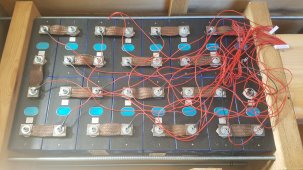As some of you may know, I'm in the process of moving my batteries into a new enclosure. Reasons: it's more organized, space is better optimized, and I can add more batteries more easily later if needed. This is the first time I took these apart since I built them somewhere early 2020. I bought the cells (LF280N) in 2019, and they have a manufacturing date in 2018, so 5 year old cells. These were bough from Haomi (long gone seller) and definitely not EV grade.
Here they are, still in their fixture with the BMS removed. That's right: no spacers between the cells, and my DIY flexible bus bars in all their glory

No bloating what so ever - and this battery was 100% full:

Didn't want to remove all bus bars, so only took of the positive terminal side where the BMS connects to while moving cells.

I did a quick capacity test (no graph on this device) while I was taking the other pack apart and putting it back together in the new enclosure: 267Ah. I have no idea how many cycles I have on these batteries, but considering that these are 5 years old, have been running the house for the past three years and counting, and cost me 100 Euro per cell shipped, I call that a win.
Here they are, still in their fixture with the BMS removed. That's right: no spacers between the cells, and my DIY flexible bus bars in all their glory

No bloating what so ever - and this battery was 100% full:

Didn't want to remove all bus bars, so only took of the positive terminal side where the BMS connects to while moving cells.

I did a quick capacity test (no graph on this device) while I was taking the other pack apart and putting it back together in the new enclosure: 267Ah. I have no idea how many cycles I have on these batteries, but considering that these are 5 years old, have been running the house for the past three years and counting, and cost me 100 Euro per cell shipped, I call that a win.


